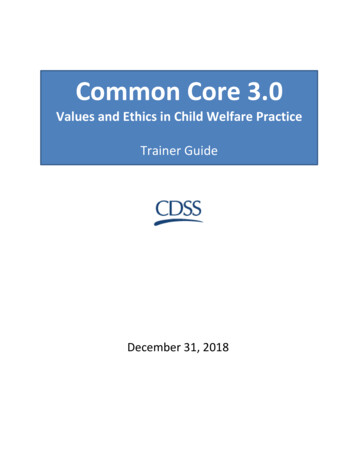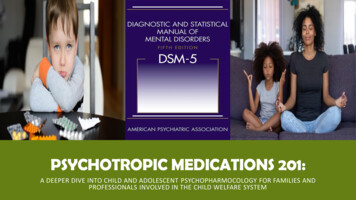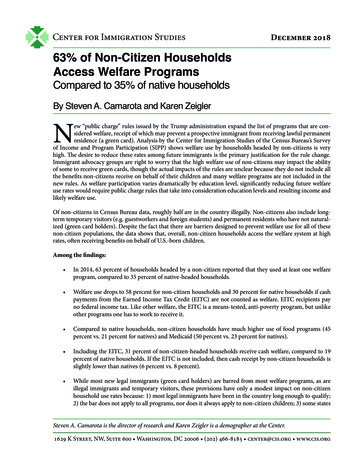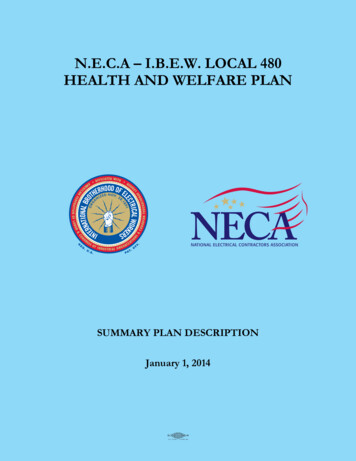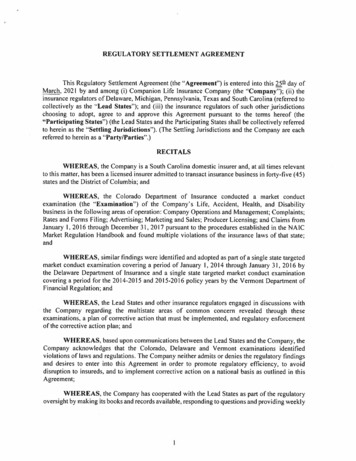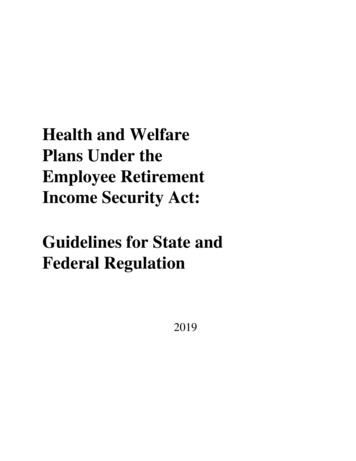
Transcription
NationalAssociation ofInsuranceCommissionersHealth and WelfarePlans Under theEmployee RetirementIncome Security Act:Guidelines for State andFederal Regulation2019
Health and Welfare Plans Under theEmployee RetirementIncome Security Act:Guidelines for State and Federal RegulationERISA (B) Working Group of theHealth Insurance and Managed Care (B) Committee 1997, 2004, 2019 National Association of InsuranceCommissionersAll rights reserved.ISBN 0-89382-107-1National Association of Insurance CommissionersInsurance Products & Services Division816-783-8300prodserv@naic.orgPrinted in the United States of AmericaNo part of this book may be reproduced, stored in a retrieval system, or transmitted in any form or by any means, electronic ormechanical, including photocopying, recording, or any storage or retrieval system, without written permission from the NAIC.Central Office1100 Walnut Street, Suite 1500Kansas City, MO 64106-2197816-842-3600Capital Markets andInvestment Analysis OfficeOne New York Plaza, Suite 4210New York, NY 10004212-398-9000Government RelationsHall of States Bldg.444 North Capitol NW, Suite 700Washington, DC 20001-1509202-471-3990
DisclaimerThese materials are intended to provide a general overview of the concepts, principles, and procedures thatthe authors and editors believe may be of assistance to a state insurance regulator. These materials are notintended to serve as a definitive statement of the law or procedural requirements of any particularjurisdiction. They are not intended and should not be construed to be binding nor should a regulator actsolely in reliance on the contents of this handbook. Materials in this handbook are not necessarily suitableor applicable for use in all situations.While these materials have been prepared at the request of the National Association of InsuranceCommissioners, they do not reflect the formal position of that organization or any individual or insuranceregulatory authority in the states, districts, or territories of the United States.Adoption of these materials is solely for the purpose of providing for its publication and distribution toparties who may have an interest in reviewing the material.The users of these materials should consult the applicable statutory provisions, judicial and regulatoryauthority and experienced or professional personnel prior to utilizing the information contained in thishandbook. 1997, 2012, 2019 National Association of Insurance Commissionersi
ACKNOWLEDGMENTSHealth and Welfare Plans Under the Employee Retirement Income Security Act (ERISA): Guidelines forState and Federal Regulation has been prepared by the National Association of Insurance Commissioners(NAIC) ERISA Working Group of the Health Insurance and Managed Care (B) Committee.A special thanks goes to the state insurance regulators who reviewed and commented on and/or draftedvarious sections included in this edition. The working group appreciates the contribution all of theseindividuals have made in helping to enhance the usefulness of this handbook. The working group alsoappreciates the significant contribution by the NAIC staff member responsible for this revision. 1997, 2012, 2019 National Association of Insurance Commissionersii
TABLE OF CONTENTSI.Introduction . 1II.ERISA Preemption of State Regulation . 4A.The Scope of Preemption1.The Preemption Clause2.The Saving Clause3.The Deemer ClauseB.Key U.S. Supreme Court Opinions on ERISA’s Preemption Provisions1.Shaw v. Delta Air Lines2.Metropolitan Life Ins. Co. v. Massachusetts3.Pilot Life Ins. Co. v. Dedeaux4.Firestone Tire & Rubber Co. v. Bruch5.FMC Corp. v. Holliday6.District of Columbia v. Greater Washington Board of Trade7.New York State Conference of Blue Cross & Blue Shield Plans v. Travelers Ins. Co.8.California Division of Labor Standards Enforcement v. Dillingham9.De Buono v. NYSA-ILA Medical and Clinical Services Fund10.UNUM Life Ins. Co. v. Ward11.Rush Prudential HMO, Inc. v. Moran12.Kentucky Association of Health Plans v. Miller13.Aetna Health, Inc. v. Davila14.Metropolitan Life Ins. Co. v. Glenn15.Gobeille v. Liberty Mutual Ins. Co.16.ConclusionIII.ERISA Plan Characteristics and Relationship to State Regulation . 22A.Non-Covered Benefit Arrangements1.General Characteristics of an ERISA Plan2.Plan, Fund or Program Established or Maintained Requirement3.Employer or Employee Organization Requirementa.Direct and Indirect “Employers”b.Employee Organizations4.Purpose Requirement5.Participants Requirement6.ConclusionB.Single-Employer Plans1.Characteristics of a Single-Employer Plan2.Single-Employer Plans and State Regulation3.ConclusionC.Multiemployer Plans1.Characteristics of a Multiemployer Plan2.Multiemployer Plans and State Regulation3.ConclusionD.Multiple Employer Welfare Arrangements1.Characteristics of MEWAs2.MEWAs and State Regulation 1997, 2012, 2019 National Association of Insurance Commissionersiii
a.b.c.d.3.MEWAs That Are Not Employee Benefit PlansFully Insured MEWAs That Are Employee Benefit PlansNon-Fully Insured MEWAs That Are Employee Benefit PlansFederal Authority to Exempt Plan MEWAs From Certain State InsuranceLawse.Exception to the MEWA Definition for Collectively Bargained Plansf.History of the Collective Bargaining Exceptiong.Final Rules Regarding Section 3(40) of ERISAConclusionIV.Typical Illegal Operations Claiming ERISA Status . 35A.Purported “Single-Employer” Plan Enrolling Consumers as “Agents”B.Purported “Single-Employer” Plans—Out of State Trusts and Stop-Loss ArrangementsC.Purported “Fully Insured” PlansD.Non-Fully-Insured Multiple Employer Arrangements Claiming “Single-Employer” PlanStatus—Issues Related to Employee Leasing and PEOV.Prevention . 44A.Consumer EducationB.Agent EducationC.Licensed Insurer EducationD.Education of Other IndustriesE.ConclusionVI.Analytical Checklist for Determining State Jurisdiction Over Entities OfferingHealth Care Benefits . 46VII.Questions and Answers About Insurance Department Jurisdiction . 49A.What is a Taft-Hartley Trust?1.Characteristics of a Taft-Hartley Trust2.Taft-Hartley Trusts and State Regulation3.ConclusionB.Can Employers Avoid State Laws Requiring Workers’ Compensation Coverage by ProvidingWorkers’ Compensation Through ERISA Plans that Also Provide Other Benefits?C.Association Coverage: Is it Individual, Small Group or Large Group Coverage?1.How Association Coverage is Classified2.Individual Market Coverage3.Group Market Coverage4.Federal Guidance on Association Coverage5.Rating Requirements for Association Health Plans6.Comparing the Options for Association CoverageD.What Is a VEBA?E.What Is the Difference Between a MET and a MEWA?F.Is a State Law That Is Used to Regulate a MEWA Preempted by ERISA?G.What Arrangements Involving Multiple Employers That Provide Health Benefits on a “SelfFunded” Basis Ease the Administrative Burden of Providing Those Benefits?H.If a MEWA That Is Not “Fully Insured” Covers Some Employees in a State, but theEmployers Are Located in Another State, Does the State in Which the MEWA Covers SomeEmployees Still Have the Authority to Regulate the MEWA?I.Is the Term “Fully Insured” Defined in ERISA?J.May a State Insurance Department Subpoena an ERISA Plan’s Books and Records or 1997, 2012, 2019 National Association of Insurance Commissionersiv
K.L.M.Conduct and Charge for a Financial Examination?Can Managed Care Organizations That Are Sponsored by Providers and Accept InsuranceRisk From ERISA Plans be Required to Obtain an Insurance License and Be Regulated UnderState Insurance Laws?To What Extent May States Regulate TPAs That Provide Administrative Services to ERISAPlans?Can States Prohibit the Use of Discretionary Clauses in Insurance Policies That ProvideERISA Benefits?VIII.ACA Changes Incorporated Into ERISA .A.Historical Background: HIPAA and the ACAB.The Large Employer “Shared Responsibility” RequirementC.Significant Regulatory Standards Applicable to Group Health Plans1.Grandfathered Status2.Wellness Programs3.Mental Health Parity4.Dependent Coverage of Children Under Age 265.Rescission Provisions6.Prohibition on Lifetime and Annual Dollar Limits on EHB7.Limits on Cost Sharing8.Prohibition on Pre-Existing Condition Exclusions9.90-Day Waiting Period10.Summary of Benefits and Coverage and Uniform Glossary11.Choice of Healthcare Professional12.Emergency Services13.Preventive Services14.Clinical Trials15.Claims, Internal Appeals and External Review16.Qualified Small Employer Health Reimbursement ArrangementsIX.Glossary . 62X.Appendices .1.Consumer Alert2.Agent Alert3.Regulatory Alert to Stop-Loss Carriers and TPAs 1997, 2012, 2019 National Association of Insurance Commissionersv
INTRODUCTIONThe Employee Retirement Income Security Act of 1974 (ERISA) 1 is a complex andcomprehensive statute that federalizes the law of employee benefits. ERISA establishes acomprehensive regulatory framework for employee pension benefit plans and preempts most statelaws regarding “employee welfare benefit plans,” a broad category that includes nearly allemployer-sponsored and union-sponsored health plans. 2However, ERISA does not preempt state insurance law. The result is a dual regulatory framework.To the extent that an ERISA plan pays directly out of plan assets (a “self-funded plan”), it is exemptfrom state regulation. To the extent that the plan purchases insurance to cover some or all of itsbenefit obligations (an “insured plan”), the state’s regulatory authority over the insurance contractresults in indirect state regulation of aspects of the plan. 3The precise boundary of state jurisdiction has been the subject of numerous disputes involvingcomplex preemption analysis. In contrast to the detailed and substantive standards that are imposedon employee pension benefit plans, there is no comparable federal regulatory program foremployee welfare benefit plans. 4 The minimal federal standards for employee welfare benefit1Public Law 93-406, codified at 29 U.S.C. §§ 1001 et seq. (2018). Note that federal laws have their own internalnumbering system, and the numbering of many titles of the U. S. Code remains “unofficial.” For example,ERISA’s preemption clause is P.L. 93-406, § 514, as amended. It is codified at 29 U.S.C. § 1144, but it is often citedas “Section 514.” The federal Affordable Care Act (ACA) and the Public Health Service (PHS) Act, discussed laterin this handbook, follow similar dual citation systems.2 The terms “ employee welfare benefit plan” and “ welfare plan” include any “program . established or maintainedby an employer or employee organization . for the purpose of providing for its participants or their beneficiaries,through the purchase of insurance or otherwise” with any of a broad range of benefits, including “medical, surgical,or hospital care or benefits, or benefits in the event of sickness, accident, disability, death or unemployment.” 29U.S.C. § 1002(1) (2018).3 While ERISA governs both the insured and self-funded plan, the term “ERISA plan” is often used colloquially torefer to a self-funded plan. In this handbook, the term “ERISA plan” is used in the correct sense to include a referenceto both the “self-funded” plan and the “insured” plan.4 ERISA was drafted specifically in response to concerns that working people were losing their pension benefits for avariety of reasons, including pension fraud, mismanagement and employer bankruptcy. With the growth in assetaccumulation and the number of pension plans, the U.S. Congress (Congress) sought to ensure that appropriatesafeguards were in place to protect pension plan funds. Congress also sought to encourage multistate employers, whomight be reluctant to form employee benefit plans in the face of 50 separate state regulatory schemes, to provideemployee benefits to their workers.It is important to note that the impetus for ERISA was the security of pension plans and not concern for health carerelated benefits. Congress’s central concern for pension plan management is evident in the text of ERISA, as well asits legislative history. Under ERISA, pension plans are subject to uniform reporting, disclosure, fiduciary,participation, funding and vesting requirements. Through these requirements, detailed and substantive standards areimposed on employers who furnish pension plans to their employees. On the other hand, only the reporting, disclosureand fiduciary responsibility requirements were made applicable to welfare benefit plans. Consequently, the law doesnot require employee welfare benefit plans to meet requirements such as financial solvency standards. However,through the Health Insurance Portability and Accountability Act of 1996 (HIPAA), P.L. 104-191, Congress did createstandards for employee health plans that limited the use of preexisting condition exclusions and prohibiteddiscrimination based on health status-related factors, and additional substantive benefit standards have now beenincorporated by reference into ERISA by the ACA, P.L. 111-148. 1997, 2012, 2019 National Association of Insurance Commissioners6
plans and the imprecision and complexity of the ERISA preemption analysis result in numerousdisputes over the limits of state jurisdiction in areas related to employee welfare benefit plans.The complexity of ERISA preemption is derived primarily from the multiple stages in the analysisof whether a state law is preempted by ERISA. When determining whether ERISA preemptionapplies, state insurance regulators must consider the following questions:1. Is the plan under consideration an ERISA plan and, if so, what type of ERISA plan?2. Does the state law “relate to” the ERISA plan? 53. Even if the law does “relate to” an ERISA plan, is it protected by the “saving clause,”which saves “any law of any State which regulates insurance” from preemption? 64. Is the “saving clause” protection limited by ERISA’s “deemer clause,” which prohibitsstates from “deeming” an employee benefit plan to be an insurer, bank or investmentcompany in order to assert their authority to regulate one of those entities? 7Determining whether a state law is preempted by ERISA is complex and confusing. Unfortunately,unscrupulous operators capitalize on this confusion and illegitimately claim that state laws do notapply to their health plans because they are preempted under ERISA. State insurance regulatorsneed to be aware of the common scams and understand ERISA in order to not fall victim to thesespurious claims. See the section on “Typical Illegal Operations Claiming ERISA Status” for adescription of some of the more common scams claiming exemption from state law under ERISA.The principal purpose of this handbook is to provide state insurance regulators with a resourceguide to help them through the labyrinth of ERISA preemption analysis. While ERISA preemptionapplies to a broader range of contexts, this handbook focuses exclusively on health-relatedemployee welfare benefit plans. The first section discusses the scope of ERISA preemption.Specifically, it provides historical background information on ERISA preemption of state law andan overview of the statutory elements of the ERISA preemption analysis. The section ends with asummary of cases in which the Supreme Court (Court) has interpreted these statutory elements.The second section of this handbook highlights the general characteristics of an ERISA plan andreviews the specific types of employee welfare benefit plans governed by ERISA: single-employerplans, multiemployer plans, and multiple employer welfare arrangements (MEWAs). It describeshow the preemption analysis applies to each individual plan type and highlights some of the typicaltheories used by sham plan operators claiming ERISA preemption from state laws. Therelationship between ERISA and Taft-Hartley trusts is also highlighted. The second section endswith an analytical checklist and chart that state insurance regulators may find useful.5 29 U.S.C. § 1144(a) (2018). It should be noted that ERISA does not apply to employee benefit plans maintained bygovernment or church employers or to plans maintained only to comply with applicable state workers’ compensation,unemployment or disability laws. There are additional exemptions from ERISA for unfunded excess benefit plans andplans maintained outside the U.S. primarily for nonresident aliens. ERISA does provide an opt-in provision forchurch employers. 29 U.S.C. § 1003(b) (2018).6 29 U.S.C. § 1144(b)(2)(A) (2018). State laws regulating banking and securities, generally applicable criminal laws,and most provisions of the Hawaii Prepaid Health Care Act (PHCA) are also saved from preemption. Id. § 1144(b)(2)–(5).7 29 U.S.C. § 1144(b)(2)(B) (2018). 1997, 2012, 2019 National Association of Insurance Commissioners7
The third section of this handbook explores a number of timely topics of interest to state insuranceregulators in a question and answer format. Some of the issues addressed in this section are basicsettled questions that are commonly asked. Other questions reflect cutting edge issues that are stillthe subject of debate.Finally, the fourth section of this handbook contains appendices that include various regulatoryalerts. 1997, 2012, 2019 National Association of Insurance Commissioners8
ERISA PREEMPTION OF STATE REGULATIONThe Scope of PreemptionThe scope of ERISA preemption is sweeping. With the exception of state regulations applied toMEWAs, any state law that attempts to regulate ERISA-covered employee benefit plans ispreempted due to federal occupation of the field. 8 However, ERISA exempts from federalpreemption state laws that regulate the business of insurance. A “saving clause” in ERISAempowers the states to enforce all state laws that regulate insurance. The broad language of thesaving clause is limited by a “deemer clause” in the statute, which has been judicially interpretedto mean that an employee benefit plan covered by ERISA cannot be deemed to be an insurancecompany or engaged in the business of insurance for the purposes of the application of state lawswhich regulate insurance. 9 Because little legislative history exists with respect to these clauses, theinterpretation of their meaning has been developed through the judicial decision making process.The “saving clause” is also limited by case law, holding that some provisions of state insurancecodes regulating insurers go beyond regulating “the business of insurance”; therefore, they arepreempted to the extent that they apply to insurance issued to employee benefit plans. 10 TheCourt’s “interpretation of the deemer clause makes clear that if a plan is insured, a State mayregulate it indirectly through regulation of its insurer and its insurer’s insurance contracts; if theplan is uninsured, the State may not regulate it.” 11This section provides a brief overview of those provisions of ERISA that: Preempt state laws “relating to” employee welfare benefit plans.Save state laws “regulating the business of insurance.”Prohibit states from “deeming” employee welfare benefit plans to be insurers or engagedin the business of insurance.Summaries of a number of key Court cases interpreting these clauses are provided at the end ofthis section.The Preemption ClauseThe preemption clause states that “Except as provided in subsection (b) of this section [referringto the saving clause] . the provisions of this subchapter and subchapter III of this chapter shallsupersede any and all State laws insofar as they may now or hereafter relate to any employeebenefit plan described in section 1003(a) of this title and not exempt under section 1003(b) of thistitle.” 12829 U.S.C. § 1144(a) (2018).FMC Corp. v. Holliday, 498 U.S. 52, 61 (1990).10 Pilot Life Ins. Co. v. Dedeaux, 481 U.S. 41, 50-51 (1987).11 FMC Corp. v. Holliday, 498 U.S. at 64.12 29 U.S.C. § 1144(a) (2018). ERISA defines state law to include “all laws, decisions, rules, regulations, or9 1997, 2012, 2019 National Association of Insurance Commissioners9
Preemption applies only to a plan that was established or is maintained by an employer and/or anemployee organization to provide any of the specified benefits to the employees of the employeror members of the employee organization. 13 The U.S. Congress (Congress) defined an employeras “. any person acting directly as an employer, or indirectly in the interest of an employer, inrelation to an employee benefit plan; and includes a group or association of employers acting foran employer in such capacity.” 14 An employee organization is defined as “any labor union or anyorganization of any kind, or any agency or employee representation committee, association, group,or plan, in which employees participate and which exists for the purpose, in whole or in part, ofdealing with employers concerning any employee benefit plan, or other matters incidental toemployment relationships; or an employees’ beneficiary association organized for the purpose inwhole or in part, of establishing such a plan.” 15The scope of ERISA preemption has been altered since the federal law’s original enactment. Thevague phrase “any person acting directly. or indirectly in the interest of an employer” in thedefinition of employer and the extremely broad scope of the language of the preemption clausecreated a troublesome loophole in ERISA. This loophole allowed unscrupulous promoters topeddle spurious health plans to all comers and claim protection from state regulation as entitiesacting directly or indirectly in the interest of employers.Congress reviewed the effect of preemption under ERISA in the Activity Report of the U.S. Houseof Representatives (House) Education and Labor Committee on Jan. 3, 1977. 16 Although theCommittee thought that the broad preemption provision of ERISA should be retained, itemphasized that entrepreneurial ventures masquerading as ERISA plans were “no more ERISAplans than is any other insurance policy sold to an employee benefit plan.” 17 The Committee alsostated “[w]here a ‘plan’ is, in effect, an entrepreneurial venture, it is outside the policy of section514 (the preemption clause of ERISA) . In short, to be properly characterized as an ERISA benefitplan, a plan must satisfy the definition requirement . in both form and substance.” 18 Thecommittee then concluded “[w]e most earnestly encourage private persons, in particular themembership of the National Association of State [sic] Insurance Commissioners, and urge theDepartment of Labor, to take appropriate action to prevent the continued wrongful avoidance ofproper state regulation by the entities.” 19 Finally, in 1983, Congress enacted language to facilitatethe efforts of the states and the U.S. Department of Labor (DOL) to establish a clear and effectiveregulatory framework for multiple employer plans. These provisions are discussed in more detailin the section on MEWAs.other State action having the effect of law, of any State,” and also any “law of the United States applicable onlyto the District of Columbia.” 29 U.S.C. § 1144(c)(1) (2018).13 29 U.S.C. § 1002(1) (2018).14 Id. § 1002(5).15 Id. § 1002(4).16 ERISA OVERSIGHT REPORT OF THE PENSION TASK FORCE OF THE SUBCOMMITTEE ON LABORSTANDARDS, HOUSE COMMITTEE ON EDUCATION AND LABOR, H.R. Doc. No. 342-9, 94th CONG., 2dSess. (Jan. 3, 1977) [ “COMMITTEE REPORT”].17 Id. at 10.18 Id. at 11.19 Id. 1997, 2012, 2019 National Association of Insurance Commissioners10
Although the 1983 amendment to ERISA reduced the scope of ERISA preemption, the potentialfor ERISA preemption of state laws for non-MEWA ERISA plans remains significant. ERISA’spreemption provision has been interpreted broadly by the federal courts. When plaintiffs seek statelaw remedies in state courts for claims related to employee benefit plans, defendants invariablyhave the cases removed to federal court where cases are usually dismissed on the grounds ofpreemption.The Saving ClauseNotwithstanding the preemption clause, ERISA does not substitute for or eliminate state insuranceregulation. To preserve state laws regulating insurance and state authority to continue to do so,Congress included a “saving clause” in ERISA. This provision reads: “Except as provided insubparagraph (B), [referring to the “deemer clause”], nothing in this title shall be construed toexempt or relieve any person from any law of any State which regulates insurance, banking, orsecurities.” 20 In other words, ERISA generally does not prohibit the states from applying stateinsurance laws to entities engaged in the business of insurance.The “saving clause” is consistent with the McCarran-Ferguson Act, 21 which Congress passed in1945 to reserve for the states the authority to regulate the business of insurance. Furthermore,ERISA explicitly states “[n]othing in this subchapter shall be construed to alter, amend, modify,invalidate, impair, or supersede any law of the United States . or any rule or regulation issuedunder any such law.” 22 Known as an “equal dignity” clause, this provision protects the McCarranFerguson Act from being superseded or modified by ERISA.The Deemer ClauseWhile the “saving clause” seeks to protect state authority to regulate the business of insurance,state insurance laws cannot be applied to employee benefit plans. The “deemer clause” states202129 U.S.C. § 1144(b)(2)(A) (2018).15 U.S.C. §§ 1011 et seq. (2018). The McCarran-Ferguson Act states in part:§ 1011. Declaration of policyThe Congress hereby declares that the continued regulation and taxation by the several States of the business ofinsurance is in the public interest, and that silence on the part of the Congress shall not be construed to imposeany barrier to the regulation or taxation of such business by the several States.§ 1012. Regulation by State law; Federal law relating specifically to insurance; applicability of certain Federallaws after June 30, 1948(a) State regulation. The business of insurance, and every person engaged therein, shall be subject to the lawsof the several States which relate to the regulation or taxation of such business.(b) Federal regulation. No Act of Congress shall be construed to invalidate, impair, or supersede any lawenacted by any State for the purpose of regulating the business of insurance, or which imposes a fee or taxupon such business, unless such Act specifically relates to the business of insurance; Provided, That afterJune 30, 1948, the Act of July 2, 1890, as amended, known as the Sherman Act [15 U.S.C. §§ 1 et seq.], andthe Act of October 15, 1914, as amended, known as the Clayton Act, and the Act of September 26, 1914,known as the Federal Trade Commission Act, as amended [15 U.S.C. §§ 41 et seq.], shall be applicable tothe business of insurance to the extent that such business is not regulated by State law.22 29 U.S.C. § 1144(d) (2018). 1997, 2012, 2019 National Association of Insurance Commissioners11
“[n]either an employee benefit plan described in 29 U.S.C. §1003(a) of this title, which is notexempt under §1003(b) of this title (other than a plan established primarily for the purpose ofproviding death benefits), nor any trust established under such a plan, shall be deemed to be aninsurance company or other insurer . or to be engaged in the business of insurance . for purposesof any law of any State purporting to regulate insurance companies, [or] insurance contracts .”23A state law that treats an employee welfare benefit plan as if it were an insurer negates the effectof the saving clause. The deemer clause does not negate the ability of the states to apply insurancelaws to those entities with which the employee welfare benefit plan has contracted to purchaseinsurance for its employees.Key U.S. Supreme Court Opinions On ERISA’s Preemption ProvisionsThe interplay between ERISA’s preemption, saving and deemer clauses and the impact of theseclauses on state regulatory authority has been the subject of a multitude of cases presented beforethe judiciary. The Court established tests to be used when evaluating whether a state law ispreempted because it “relates to” an employee benefit plan or because the state law “deems” anemployee benefit plan to be an insurer or to be engaged in the business of insurance. The Courtalso established tests to be used when evaluating if a state law is “saved” because it regulates “thebusiness of insurance.”The guidance established in the Court cases is further augmented by lower court opinions. Whilethe Court has provided the lower courts with direction not readily apparent in the statutorylanguage, the complexity of the statute and the fact-specific nature of the cases that the courts mustdecide result in an uncertain judicial decision-making process. Lower courts often reachconflicting decisions in interpreting similar state laws. As a consequence, legislators, stateinsurance regulators, employers, and insurers sometimes have difficulty predicting what the courtswill consider a “preempted” or “saved” regulatory initiative.The Court furt
c. Non-Fully Insured MEWAs That Are Employee Benefit Plans . d. Federal Authority to Exempt Plan MEWAs From Certain State Insurance . disability, death or unemployment." 29 U.S.C. § 1002(1) (2018). 3. While ERISA governs both the insured and self-funded plan, the term "ERISA plan" is often used colloquially to . employee benefits to .




